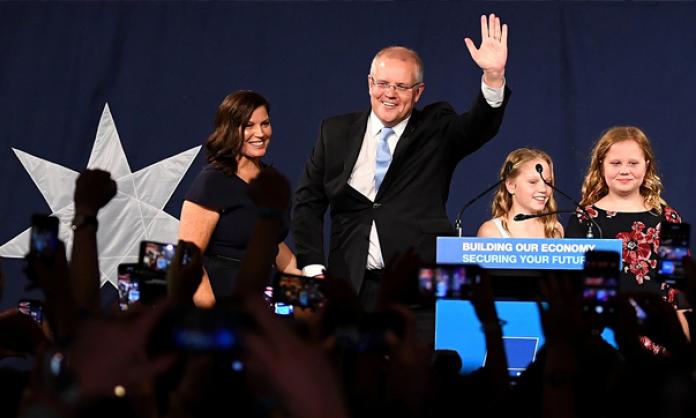If you followed much of the mainstream media and listened to some of the Coalition’s boasting, you’d get the impression that the conservatives swept all before them on 18 May. Many progressives have gone along with this, believing that the national mood has swung towards conservatism and there is therefore little point trying to mobilise a fightback against the new government.
The reality is rather different. Morrison eked out a relatively narrow victory, which can be shown in a range of ways.
The Coalition scored a lower primary vote in the House of Representatives than when it scraped through at the 2016 election, which was seen at the time as an electoral setback for the Turnbull government. Its primary vote was also lower this time around than when it lost elections to Bob Hawke’s ALP in 1983 and Kevin Rudd in 2007.
The Coalition has been returned to office with fewer lower house MPs than the ALP in five of the eight states and territories. In only two states, Queensland and Western Australia, are there more Coalition members than Labor. That Queensland now accounts for one-third of the entire complement of Coalition members is an indication of both the conservative domination of that state but also the Coalition’s vulnerability should it turn against them.
In only two states, Queensland and Tasmania, did the Coalition make any seat gains.
Regardless of the appalling Labor vote – its lowest since soon after its foundation in 1901 (if you eliminate the exceptional circumstances of the early 1930s, when the ALP split) – the outcome in lower house seats is virtually identical to the situation as it stood after the 2016 election. Losing just two seats in by-elections in the next year or two would put the government back to minority status.
**********
The Coalition and its supporters in the media like to claim that the government was re-elected off the back of a big swing by “battlers”, particularly in the regions – what resources minister Matt Canavan called “the hi-vis revolution”. On election night, Barnaby Joyce said that Labor had abandoned its blue collar base, which had flocked to the conservatives.
This argument seemed to win support from a study published by the Guardian a few days after the election. It showed that the Coalition won swings in electorates characterised by higher unemployment, lower incomes and lower educational qualifications.
But the analysis was misleading at best. Some of the swing is more due to how the states swung rather than the specifics of particular electorates.
We can tell whether the Coalition’s claims are true only by looking at the voters themselves. A big Sydney University survey of 10,000 voters found no basis to the argument that the Coalition cleaned up the battlers.
Far from swinging towards the right, those with some combination of low incomes, reliance on disability pensions and family tax benefits, and those who were employees were much more likely to vote Labor than the Coalition. Those with high incomes, not on welfare and who were self-employed or ran a business overwhelmingly voted for the Coalition.
This election only confirmed traditional class-based voting allegiances. The predominantly working class western and northern suburbs of Melbourne and the southern and western suburbs of Sydney for the most part stayed solidly Labor. The affluent eastern suburbs of Melbourne and Sydney, the north shore and northern beaches of Sydney all remained resolutely Liberal.
The Morrison government won not because it won the bulk of the working class, but because it kept its middle class and capitalist backers loyal with the promise of vast handouts stolen from the pockets of the poor.
**********
Even though it is early days and the situation will become clearer in coming months, the signs so far are that the ALP has responded to its election loss by shifting in precisely the wrong direction.
Labor took what was, by comparison with its program in recent decades, a relatively leftish manifesto to this election. It promised to raise taxes on the upper middle class to fund a big expansion of spending on health and education. The party now looks set to abandon much of this under its new leader, the left faction’s Anthony Albanese.
Since the election, Albanese has argued that Labor must drop what he claims is the “anti-business” rhetoric that Bill Shorten ran with during the election campaign. He will instead “steer the party back to the policy centre”. Albanese told the Labor caucus on 30 May: “I speak about the need to talk about aspiration and to appeal to people who want to get on in life and want a better life for themselves. I want to appeal to people who are successful as well as lift up people who aren’t as successful”. It was all he could do not to parrot Morrison’s empty phrase: “If you have a go, you'll get a go”.
Labor’s first serious test will come in July, when the Morrison government plans to table its next three rounds of tax cuts in parliament. Under Shorten, Labor said it would oppose the second and third rounds, which are overwhelmingly biased in favour of the well-off. Albanese has said that under his leadership, the party is reserving judgement on which way they will vote, and his main objection to them is not that they are massively regressive but only that they might blow the budget.









